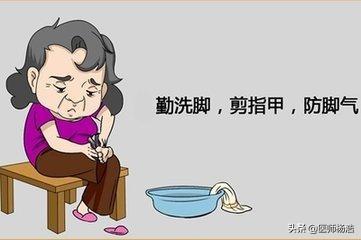How do you clean a rotten diabetic foot?
Diabetic foot rot, which we often refer to as diabetic foot disease, is one of the most serious and expensive chronic complications of diabetes to treat, and if not managed well, it can lead to paraplegia or even death in severe cases. So, with diabetic foot disease, our main emphasis is on preventing its occurrence.

How can diabetic foot be prevented?
- Control blood glucose and monitor it regularly (the first thing you do to prevent all diabetic complications is to control your blood glucose)
- Regularly check for foot lesions such as foot deformities, ulcers, skin color changes, dorsal arterial pulsations and abnormalities in skin temperature and sensation. (You or your family members may check your feet, especially between the toes, every day, or ask a professional to do so if necessary.)
- Wash feet at the right temperature, preferably not more than 38 ℃
- Wash your feet every day and dry them with a dry cloth, paying attention to the dryness between the toes.
- Winter heating care not to directly use hot water bags, electric heaters and other warmth
- Avoid walking barefoot
- Don't use chemicals when trimming your feet, and have the keratinized tissue trimmed by a professional
- Check for foreign objects or abnormalities in shoes before putting them on, don't wear socks or shoes that are tight or burlap, and don't wear socks higher than your knees
- Dry foot skin can use ointment skin care products
- If diabetic foot disease occurs in a timely manner to the hospital, the health care provider to assess the extent of foot lesions, so as to make individualized treatment guidance.

How do you clean a rotten diabetic foot?
It can be cleaned directly with water or with saline, and depending on the severity of the condition, debridement or removal of tissue debris from the wound can be performed under the care of a healthcare professional
Selection of appropriate dry dressing for bandaging
In severe diabetic foot disease, cleaning alone may not be enough to control the progression of the disease, so it is necessary to be evaluated by a healthcare professional whether to apply antibiotics or surgical treatment at the same time.

The above is about some of the relevant knowledge of the diabetic foot, thank you for reading, it is not easy to code, welcome to praise, comment, forwarding oh, I hope to help you. I am a physician Yang Hao, focusing on common diseases, multiple disease diagnosis and treatment, chronic disease management, health science. If you want to know more about medical knowledge, welcome to pay attention to this headline!
Good question, I am a medical worker, I will answer this question. Diabetic foot as one of the more serious complications of diabetes, is due to the combination of peripheral neuropathy and varying degrees of peripheral circulation disorders caused by lower limb infections, as well as the formation of ulcers and deep tissue destruction, and even the emergence of limb necrosis. Its clinical manifestations are foot pain, skin ulcers and gangrene, and severe diabetic foot can cause amputation or even death.

How to clean diabetic foot rotting foot? Diabetic feet should not only be kept clean, but also be treated in a combination of three major areas: traditional Chinese medicine, surgery and internal medicine.
purge
Wash your feet with lukewarm water every day, the water temperature is controlled at 37-39 degrees Celsius is good, not too high temperature to avoid burns. When suffering from athlete's foot, you should actively treat athlete's foot and avoid scratching with your hands to prevent infection caused by scratching the skin. Dry your feet with a soft towel after washing, especially the skin between the toes. Use moisturizing oil or ointment when the skin is dry to keep the skin lubricated, but it is forbidden between the toes.

Chinese medicine
For the treatment of diabetic foot, traditional Chinese medicine has been gradually recognized and widely used by medical experts at home and abroad for its long history, rich experience and remarkable curative effect.
medical treatment
If the diabetic foot has become gangrenous, it is a systemic healing process that takes place in three stages.
1、Basic treatment: basic treatment throughout, strict control of blood glucose, anti-infection, large blood vessels dredging, improve microcirculation and other supportive treatment.
2、Decortication stage: after basic treatment and blood sugar infection control, focus on decortication, surgical debridement, removal of necrotic tissues, increase the depth of drainage, keep the wound clean, and create conditions for muscle growth.
3、Muscle growth stage: After the above two stages, the systemic condition improves, the local secretion decreases, the necrotic tissue is removed, and new granulation tissue begins to grow.
surgical treatment
1. Reconstruction of the arterial vasculature: this can be done by vascular bypass surgery or endarterectomy.
2, interventional therapy: generally percutaneous angioplasty, endovascular stent formation, thrombus capsule removal, vascular atherosclerosis scar excision, and laser angioplasty.
3. Amputation

In short, the diabetic foot must pay attention, control blood sugar, scientific medication, enhance health care awareness, wear soft shoes and socks that fit the foot, avoid local pressure and friction and breakage. The foot is not in direct contact with too cold or too hot objects to avoid frostbite or burns.
That's all the questions answered, thanks for reading.
I'm a small nurse with big health, follow me and let's take care of our health together.
{!-- PGC_VIDEO:{'status': 0, 'thumb_height': 1088, 'file_sign': 'a3b815a1c3ea85e3e5b044105e4c79bf', 'media_id': 1616119927820291, 'vname': 'u7cd6u5c3fu75c5.mp4', 'vid': 'v020043b0000boak0h2epr11k4fu5bjg', 'src_thumb_uri': 'tos-cn-p-0026/45d715ac5fa10ef737dacefc114a8766', 'sp': 'toutiao', 'vposter': 'http://p1.toutiaoimg.com/origin/tos-cn-p-0026/45d715ac5fa10ef737dacefc114a8766', 'thumb_width': 1920, 'duration': 60.419, 'vu': 'v020043b0000boak0h2epr11k4fu5bjg', 'item_id': 6779396555133682189, 'user_id': 106073645834, 'thumb_url': 'tos-cn-p-0026/45d715ac5fa10ef737dacefc114a8766', 'group_id': 6779396555133682189, 'md5': 'a3b815a1c3ea85e3e5b044105e4c79bf', 'video_size': {'high': {'duration': 60.419, 'h': 480, 'subjective_score': 0, 'w': 848, 'file_size': 2505537}, 'ultra': {'duration': 60.419, 'h': 720, 'subjective_score': 0, 'w': 1270, 'file_size': 5222877}, '1080p': {'duration': 60.419, 'h': 1080, 'subjective_score': 0, 'w': 1906, 'file_size': 10969809}, 'normal': {'duration': 60.419, 'h': 360, 'subjective_score': 0, 'w': 636, 'file_size': 1840887}}} --}
Diabetic rotten feet rotten feet is diabetic microvascular damage to people's feet resulting in foot rot feet. To carry out trauma treatment.1, cover the trauma with a medical cotton ball or gauze soaked in rehabilitation solution for 3O minutes to treat the trauma for infection.2, clean the necrotic tissue at the trauma thoroughly and disinfect it.3, apply expectorant and extracting toxin and muscle growth ointment on the cleaned trauma, and at the same time cooperate with physical therapy for 1-2 hours to keep the trauma moist and stimulate the rapid growth of granulation tissues.4, take Combination of traditional Chinese and western medicine to control blood sugar, anti-infection, vasodilatation and nerve nutrition to promote wound healing.
The people say diabetic foot rot is the diabetic foot caused by skin ulceration caused by infection, after the spread of infection caused by tissue necrosis. Diabetic foot microvascular blood flow is relatively poor, the sensory function is also relatively poor, the protective ability is reduced, easy to cause ulcers to produce skin ulceration, due to poor blood flow, poor repair ability, it is easy to lead to infection. Peripheral resistance is poor, once the infection occurs, treatment is not timely infection surface will gradually expand, further leading to peripheral tissue microvascular damage, peripheral soft tissue ischemia, resistance is even worse, it is easier to make the infected surface proliferation, expansion, the common people say foot rot. To actively hospitalized surgical treatment, infection control to clear, surgical or vascular surgery with bone transfer technology to stimulate microvascular regeneration, to promote the healing of the infected surface. If the infected surface of the ulcer is large, sometimes it is necessary to amputate the limb to let the wound close.
Diabetic foot refers to the lesions caused by diabetic neuropathy, which includes sensory impairment of the uncinate nerves, unresponsiveness and damage to the vegetative nerves, peripheral microvascular occlusion caused by vascular disease-arteriosclerosis in the lower limbs or microangiopathy in the skin, as well as pain, ulceration, and gangrene of the foot due to bacterial infections.

Diabetic foot rotting is one of the common complications of diabetes, which makes prevention and care of diabetic foot especially important.
1、Blood sugar control, diet control, regular medication, and regular blood sugar checks are the basis for preventing diabetic complications.
2, do a good job of foot cleaning, warm water every day to wash your feet, pay attention to the water temperature should be lower than 37 degrees, with the hand to mix the water temperature evenly, to prevent foot burns, and check the foot has no breakage. Do wash your feet before measuring the water temperature, wash your feet with a soft dry towel after wiping, especially between the toes. Keep foot washing time within 10 minutes.
3, wear loose cotton shoes and socks to avoid foot extrusion leading to local microcirculation obstacles, aggravating the lesions.
4, winter in order to prevent skin cracking, can be appropriate to apply moisturizer, keep the foot skin lubrication.
5, dietary attention to low-fat, low salt, low amount of high-quality protein, to ensure that the intake of reasonable and adequate nutrition.

In short, diabetic foot rotting feet at the beginning of attention to the above 5 outside, please promptly to the endocrinology, surgery and timely consultation, and then ask the specialist to help you take the pulse, diabetic foot ulcers are difficult to heal.
I've heard that diabetes can cause the complication diabetic foot, I've heard that diabetic foot requires amputation, and I've heard that after amputation, the patient won't live long! I don't know if you've heard this before, but diabetic foot is a complication of diabetes that requires amputation, and after amputation, the patient doesn't live very long! Is it true that all diabetic feet need to be amputated? Is there really no cure for diabetic foot? Is diabetic foot an incurable disease?
In fact, it is very simple to say that the diabetic foot is not incurable, the diabetic foot it is not incurable, the diabetic foot is not a must amputate.
Diabetic foot is not something that the human body has, can be obtained also can be removed, the reason why many people with diabetic foot suffered from a long time to heal, and then faced with amputation, most of them are still very much related to the treatment methods they receive. The treatment of diabetic foot it is necessary to carry out a comprehensive assessment, systematic treatment, the overall improvement. It's not just a matter of lowering blood sugar, administering some antibiotics, reducing inflammation, or changing medications.
A little more detailed is the need for infected wounds for a reasonable, professional, effective debridement, those that prevent the growth of healthy tissue are cleaned up, debridement of wounds can be seen in the healthy tissue, to the wound healing medication, absorption, provides a good therapeutic environment, increasing the efficiency of the wound infection control.
However, this debridement is not every surgeon can do the expected rehabilitation effect, because the diabetic foot infection is very complex and multi-sex, at any time there is a mutation of the infecting bacteria, so this is a challenging debridement, inexperienced, not a professional debridement division may be in the debridement of this debridement on the failure of the work, even if the debridement, debridement of the timing, number of times, if the method of the error, then If the timing, frequency and method of debridement are wrong, then the treatment effect of later trauma rehabilitation will be affected. Our specialty has also received such a patient, before the transfer is also after the debridement, but still did not let the wound healing seal, did not achieve the expected therapeutic effect, which is sufficient to prove that, debridement, debridement, seemingly simple, the actual operation is not simple.
Figure This is my podiatry specialty of professional physicians for patients to do clearing, please more, or please less will affect the later treatment, sometimes for a serious infection of the patient to clear a noon, so often, diabetic foot is not no rule of law, just that no one is willing to be so to cure just.
For the debridement is only one part of the treatment, on the basis of this treatment, it is also necessary to improve the occlusion of the patient's lower limb blood vessels to establish collateral circulation, so that the occluded blood vessels blood flow, so as to give the trauma after debridement of the wound in a timely manner of nutrients. In addition to focusing on the wound infection, vascular occlusion, neuropathy, there is also a point of necessary concern, that is, to focus on the overall physical problems with the patient's own body, improve the phenomenon of malnutrition, because the patient suffered from diabetic foot pain for a long time, it will be mixed with the decline in all aspects of body functions, mental state, emotional instability, etc., which not only affects the control of blood glucose, but also affect the overall therapeutic effect. These not only affect the blood sugar control, but also affect the overall therapeutic effect. Therefore, it is recommended that diabetic foot patients, in order to get effective treatment of diabetic foot, then please go to the hospital with a diabetic foot specialist in time to go to the clinic.
This question and answer are from the site users, does not represent the position of the site, such as infringement, please contact the administrator to delete.